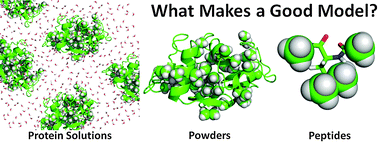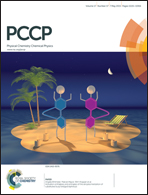Painting biological low-frequency vibrational modes from small peptides to proteins†
Abstract
Protein low-frequency vibrational modes are an important portion of a proteins' dynamical repertoire. Yet, it is notoriously difficult to isolate specific vibrational features in the spectra of proteins. Given an appropriately chosen model peptide, and using different experimental conditions, we can simplify the system and gain useful insights into the protein vibrational properties. Combining neutron scattering, depolarized light scattering, and molecular dynamics simulations, we analyse the low frequency vibrations of biological molecules, comparing the results from a small globular protein, lysozyme, and an amphiphilic peptide, NALMA, both in solution and in powder states. Lysozyme and NALMA present similar spectral features in the frequency range between 1 and 10 THz. With the aid of MD simulations, we assign the spectral features to methyl groups' librations (1–5 THz) and hindered torsions (5–10 THz) in NALMA. Our data also show that, while proteins display boson peak vibrations in both powder and solution forms, NALMA exhibits boson peak vibrations in powder form only. This provides insight into the nature of this feature, suggesting a connection of BP collective motions to a characteristic length scale of heterogeneities present in the system. These results provide context for the use of model peptide systems to study protein dynamics; demonstrating both their utility, and the great care that has to be used in extrapolating results observed in powder to solutions.


 Please wait while we load your content...
Please wait while we load your content...